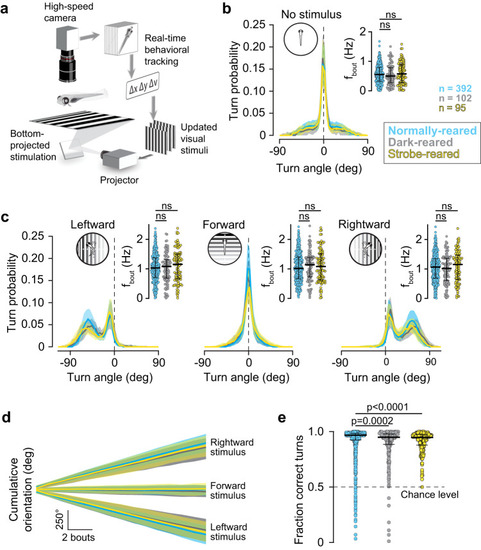|
The OMR matures in the absence of visual experience. a Experimental setup; freely swimming fish are monitored with a camera while left- or rightward moving gratings are presented. Heading angle (Δν) and fish position (Δx, Δy) are extracted to lock visual stimuli to the animal’s body axis. Modified with permission from Naumann et al. (2016). b Turn statistics of fish in absence of visual stimulus. Lines indicate median probability of swim bout angles over 30 trials for fish reared under a normal 14/10 h light/dark cycle (blue), in total darkness (black), and for fish reared under a 14/10 h cycle consisting of a 1 Hz strobe light and darkness, respectively (yellow). Error bands indicate quartiles of the probability of performing a given swim bout. Inset, average bout frequency of individual fish under the same experimental conditions; dots, bout frequency of individual animals across all trials; horizontal bar, median; error bars, interquartile range; n, number of animals (same across all panels). c Turn statistics and bout frequencies of fish when shown leftward-moving (left), forward-moving (center), and rightward-moving gratings (right). Panel layout as in (b). d Cumulative change of the animals’ rotation over time for control, dark-reared and strobe-reared fish. Lines and error bands indicate median responses and quartiles for rightward-moving (top), forward-moving (middle), and leftward moving stimuli (bottom). e Proportion of "correct" turns made by control fish, dark-reared fish, and strobe-reared fish over 30 trials. Dots, performance of individual animals across all trials; horizontal bar, median; error bars, interquartile range. The non-parametric, two-sided Kolmogorov-Smirnov test was used to test for significant differences in all panels. Source data are provided as a Source Data file.
|

